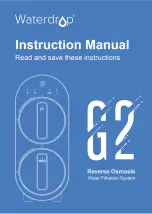
Element
Section 4: General Piping Guidelines
L-OMM-0003_A
• 10/8/2021 Technical Support • (800) 526-0288 • Mon-Fri, 8 am - 5 pm EST Page
23
of
157
4
GENERAL PIPING GUIDELINES
4.1 Inlet and Outlet Connections
W A R N I N G :
Hot outlet and cold-water piping materials connected to this product must be suitable for
temperatures up to 212ºF at normal operating water pressures.
1. Use only non-ferrous water piping and fittings. Do not use galvanized pipe or fittings. Use of
ferrous or galvanized pipe or fittings can cause rust to form.
2. Install shut-off valves and unions on the inlet and outlet water piping before servicing. Use
caution when threading pipe connections to prevent cross threading or over-tightening.
Always use a back-up wrench on tank nipples when tightening unions, valves, etc.
3. Insulate hot water and return circulation lines. Insulate cold water supply lines if subject to
freezing during shutdown periods.
IMPORTANT!
Do not use the plumbing connected to the Element as a ground for any purpose.
4. If not utilizing the return connection, contact your Lync rep.
5. Pipe the drain valve to a suitable open drain capable of receiving temperatures up to 212ºF.
6. For maximum efficiency, cold water into the Element should not exceed 100ºF. It is
recommended that the building return or dishwasher recirculation piping be connected to the
return water connection, not to the cold inlet water supply. The Element utilizes cold inlet
water to extract heat energy and allow the use of PVC vent pipe. Higher cold inlet water
temperatures will reduce heater efficiency and increase the vent temperature. If the vent
temperature approaches the maximum allowed, a vent temperature limit switch will cycle the
heater off to protect the PVC vent.
W A R N I N G :
Risk of severe scalding is present if downstream valves and fittings are not set to reduce point-
of-use water temperatures to meet local code requirements.
7. While dependent on incoming water conditions, it is recommended to place an initial 20µm
sediment filter on both the cold and recirc inlets in order to minimize a buildup of large
sediment in the filters.
















































